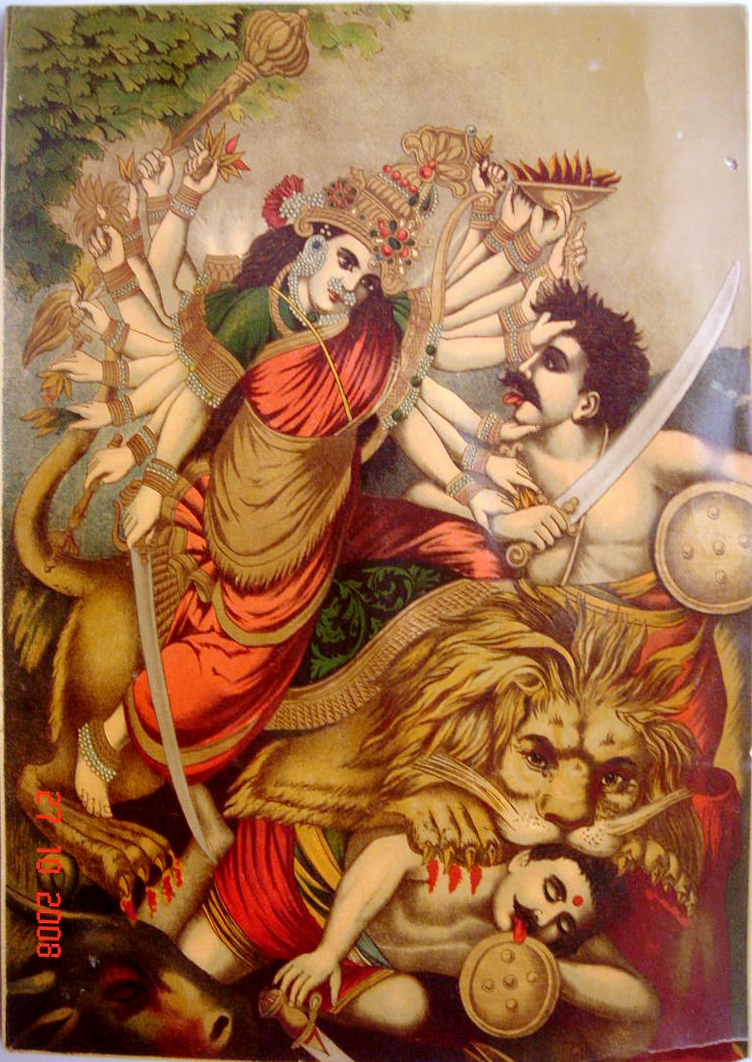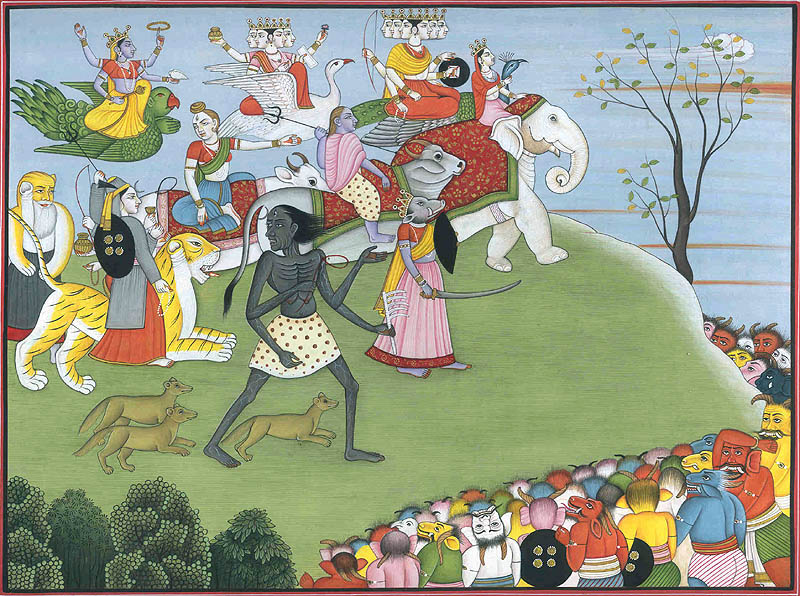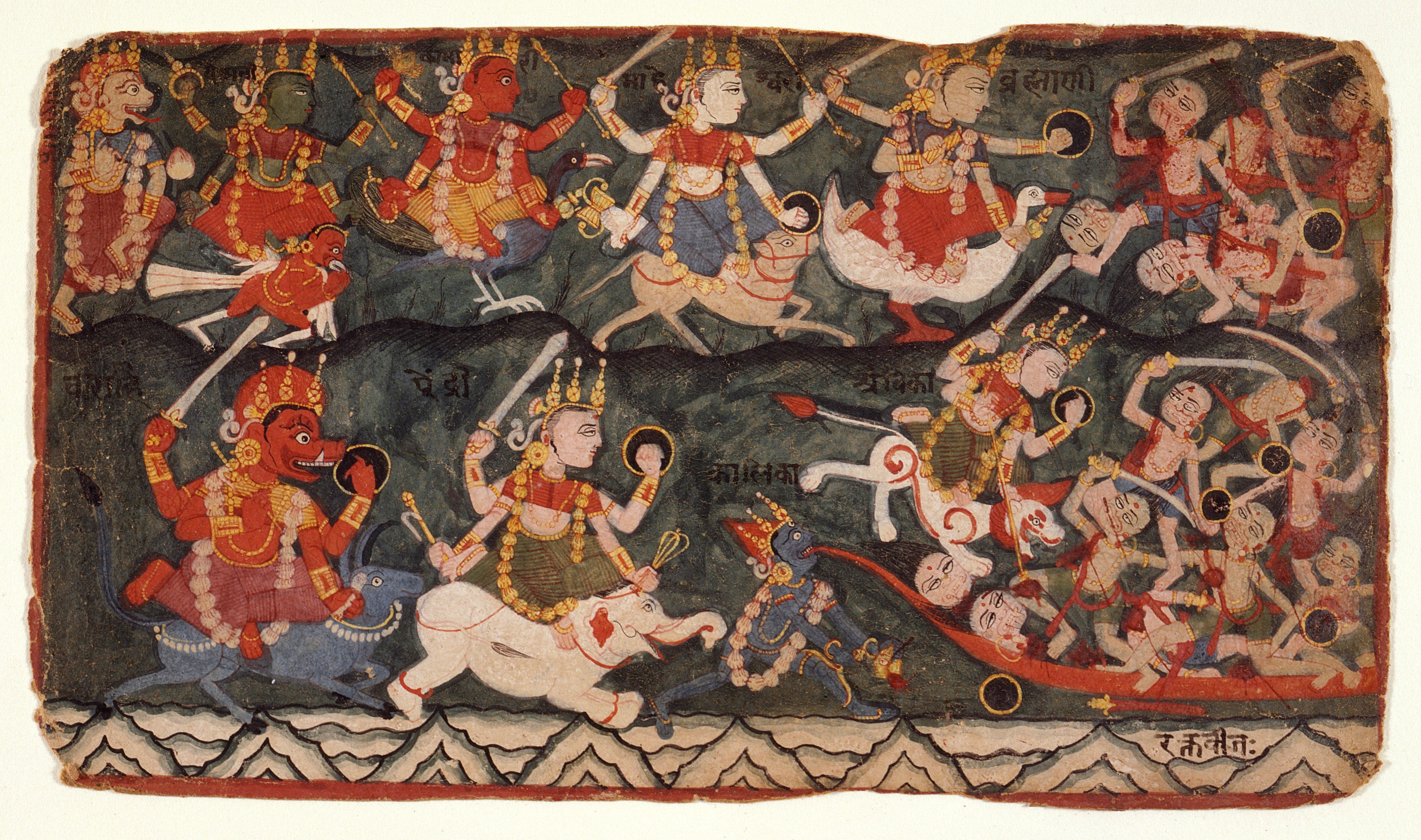Devi Navaratri and Vijaya Dasami is one of the most celebrated for Hindus all over the world. There are several stories of victory, of the noble over evil, associated with Aswiyuja Dasami. The first ten days of this month are celebrated as Navaratri culminating in Dasami the day of victory. As per traditions these are the nine days when Devi’s divine armies fought and eliminated Asura armies. While Devi Navaratri is celebrated by all the Sakta traditions, it is celebrated primarily as Candi tradition. The Godhead is called Durga, Candi, Candika, Camundi.
The Story of Devi’s Glorious Deeds
Devi Navaratri story is best narrated in Markandeya Purana as the celebrated Candi/Devi Saptasati, also called Devi Mahatmya. It is a thirteen chapter narrative of seven hundred verses.
The dhyAna Sloka for canDI vidya best summarizes the story of Devi:
“yA devI madhu kaiTabha praSamanI yA mAhishonmUlinI
yA dhUmrekshaNa canDa munDa damanI yA rakta bIjASanI
yA SumbhAdi niSumbha daitya damani yA siddha lakshmIH parA
sA canDI navakoTi Sakti sahitA mAM pAtu viSveSvarI “
The 13 chapters are grouped into three caritra-s or main stories. The presiding deities of the three are Maha Kali, Maha Lakshmi and Maha Saraswati. In the ancient Sankhya traditions these three main deities represent the three primal qualities of nature: tamas, rajas and satva. The three stories of Devi also are symbolic of these qualities. In Vedic imagery the principles (tatva-s) underlying these three qualities are represented by Agni, Vayu and Surya. The corresponding powers (Sakti-s) are the devi-s nandA, SAkambarI and bhImA. This is in contrast to the other great tradition of Lalita, where the three main divisions are those of energy instead of qualities: the powers of will, knowledge and action (iccha, jnAna and kriya).
First Story
A king Suratha and a trader Samadhi arrive at Rishi Medha’s abode, the king having lost his kingdom to enemies and the trader being driven away by his greedy wife and sons. Devi’s glorious deeds are narrated to them by the Rishi. Having heard the narrative with great attentiveness and meditated on Devi, Suratha and Samadhi regain their lost possessions with the grace of the Mother and return happily to their places and positions.
The first story is that where Vishnu, having vanquished Asura-s, goes into yoga nidra. From His ear and nasal wax two Asuras named Madhu and Kaitabha emerge. As they trouble the worlds, Devatas try waking up Vishnu. They fail to awaken the great god, and prey Devi the Yoga Maya/Maha Maya. With Her undoing Maya Vishnu wakes up and slays the two Asuras. The Devi that wakes the universe from its Tamas, is Maha Maya. Maha Kali is the presiding deity of this story. Its Rshi is Brahma and seed power Rakta Dantika Devi.
Second Story
 The second story is of Devi Durga/Mahishasura Mardini. The powerful Asura King Mahishasura defeats the divine armies of Indra and having lost swarga to the enemies Indra and other Devatas approach the primal Gods Vishnu and Siva. Then the three primal gods (trimurty) with their will give their energies unto a common form. All the devatas contribute their powers to the form and the collective energy form thus resulted, takes the form of the primal energy/Para Sakti Durga. Exceedingly beautiful, radiant, powerful, possessing all forms of weapons and riding a lion, the Mother is worshiped by the Devatas and then assures them of success.
The second story is of Devi Durga/Mahishasura Mardini. The powerful Asura King Mahishasura defeats the divine armies of Indra and having lost swarga to the enemies Indra and other Devatas approach the primal Gods Vishnu and Siva. Then the three primal gods (trimurty) with their will give their energies unto a common form. All the devatas contribute their powers to the form and the collective energy form thus resulted, takes the form of the primal energy/Para Sakti Durga. Exceedingly beautiful, radiant, powerful, possessing all forms of weapons and riding a lion, the Mother is worshiped by the Devatas and then assures them of success.
The Devatas who lost a hundred battles to the Asura hosts, set into the war led by Durga and her armies of feminine divinities. In a fierce battle thus ensuing, Devi’s armies destroy Mahisha’s armies. Devi slays Mahisha’s best generals such as cikshura, cAmara, udagra, uddhata, bAshkala, tAmra, andhaka, ugrAsya, ugravIrya, mahAhanu, viDAla, durdhara and durmukha. Then the Mother, riding Her fierce lion, destroys Mahisha’s remainder armies along with their lord Mahishasura.
Devatas, liberated from their troubles, profusely praise Devi and her grace, beauty and powers. This story is the one of victory over the second of natural qualities, rajas. The inertia of sleep and its fruits represent Tamas in the first story, which Devi wakes the world from. In this story Mahisha represents the rajo guNa, from which Devi leads the seeker to a superior consciousness quality of knowledge, the satva guNa. Maha Lakshmi is the presiding deity of this story. The Rshi is Vishnu and seed power Durga.
Third Story
 The third story is the most elaborate one of the three and the one that fulfills higher cravings of beings. It represents the numerous complex struggles in the higher reaches of nature and the ultimate taming of those with divine grace. Its consciousness quality is the satva guNa and presiding deity is Maha Saraswati the Goddess of divine Vidyas. Rudra is the Rshi and seed power Bhramari Devi.
The third story is the most elaborate one of the three and the one that fulfills higher cravings of beings. It represents the numerous complex struggles in the higher reaches of nature and the ultimate taming of those with divine grace. Its consciousness quality is the satva guNa and presiding deity is Maha Saraswati the Goddess of divine Vidyas. Rudra is the Rshi and seed power Bhramari Devi.
As the third story begins, Amba, the Devi canDikA is worshiped by the Devatas. As two asuras canDa and munDa come to know of Her unparalleled beauty and grace, they narrate it to their lord, Sumbha the king of asuras. Sumbha, wanting to marry Her, sends a messenger with his proposal. Devi replies that She will be obliged to marry only the one who defeats Her in a battle.
Sumbha, knowing of this, sends his general dhUmrAksha with an army to defeat and bring Devi unto him. As dhUmrAksha declares the war, Devi attends with Her divine armies and effortlessly kills the general along with his army.
Having lost dhUmrAksha, canDa and munDa set out with their armies to fight Devi. In the terrible encounter Devi deputes Her fierce power kAlI to destroy the enemies. Divine armies rout the monster’s armies. kAlI of terrible feats kills both canDa and munDa fearsomely and returns to canDikA the Mother, having worn their heads in a garland.
Sumbha and niSumbha then dispatch their generalissimo raktabIja along with all their generals leading a large host to wage and win an all-out war. udAyudha with his eighty six, kambu with his eighty four, koTi vIrya’s fifty and dhUmra’s hundred armies followed raktabIja. kAlaka, daurhRda, maurya, kAlakeya also set out with their deputies and host clans.
 In the fierce battle Devi assumes all the Devata powers in feminine forms: nArasimhI, kaumArI, aindrI, vaishNavI, mAheSvarI, cAmunDI, brAhmI, vArAhI etc. These are called the mAtRka powers, seven of which are primal. Devi’s divine armies, led by Her deputy kAlI, rout the asura armies and generals. On eighth day of the battle, raktabIja invokes his mystic powers because of which every drop of his blood falling on earth gives rise to a new raktabIja. The field infinitely multiplies with the asura as their blood flows and each of them fights fiercely. As Devi’s weapons injure the asura more, the more his forms multiply.
In the fierce battle Devi assumes all the Devata powers in feminine forms: nArasimhI, kaumArI, aindrI, vaishNavI, mAheSvarI, cAmunDI, brAhmI, vArAhI etc. These are called the mAtRka powers, seven of which are primal. Devi’s divine armies, led by Her deputy kAlI, rout the asura armies and generals. On eighth day of the battle, raktabIja invokes his mystic powers because of which every drop of his blood falling on earth gives rise to a new raktabIja. The field infinitely multiplies with the asura as their blood flows and each of them fights fiercely. As Devi’s weapons injure the asura more, the more his forms multiply.
To vanquish the asura kAlI the Mother with large tongue, spreads Her tongue in the entire field and drinks off all the blood as it spills even before it reaches ground. Dried of his blood, the asura becomes powerless and Devi slays him. The day of his killing is said to be the most fearsome day of the war and is celebrated as durgAshTamI.
Finally niSumbha the powerful asura is slain along with his army, following which Devi kills Sumbha the lord of asura-s on the ninth day, celebrated as maharnavami. Freed from asuric tyranny, Devatas worship Devi and the graceful mother, pleased with the praise, grants boons to the Devatas. This is the story of sAtvik struggle and divine grace helping the seeker grow over even the third quality of consciousness, resulting in a triguNAtIta or the realization of absolute reality.
The king and virtuous trader, Suratha and Samadhi, by the virtue of listening to the stories with devotion and meditated on Devi, attain the grace and vision of Devi who then grants boons to them. They regain their possessions and positions and return.
The nine days of war in which divine armies vanquish the forces representing dark side of nature are celebrated as the Devi navaratri-s, consummating in the tenth day as vijaya daSami or the celebration of victory. The presiding deities of these nine days are nine forms of Devi, called navadurga-s. They are SailaputrI, brahmacAriNI, candraghanTA, kUshmAnDA, skandamAtA, kAtyAyanI, kAlarAtrI, mahAgaurI and siddhidAtrI. This is the navArNa nAma mantra of Devi which can be chanted at any time without formal initiation: Aum namascanDikAyai namaH.This is also the day on which Arjuna vanquishes Kaurava host in gograhaNa, during their ajnAta vAsa.
The Vidya
Devi mAhAtmya is among the most celebrated texts of Hindus and unlike Sruti and some of the Saiva vidyas which are primarily dvija practices, canDI worship is meant for all four varNa-s. Besides, canDI worship is said to be especially suitable for kali yuga, through the saying “kalau canDI vinAyakau”. May there be peace and prosperity in the society by the grace of the Mother.
Celebrating Mahishasura and the Politics
 Some hate groups have been trying to celebrate Mahishasura instead of his slayer. As per them, Mahisha was a low caste representative who was oppressed (Devi high caste?). While the wise of India cannot obviously dare read misogyny into any of the anti-Hindu campaignds assuming the color of caste hatred, we need to understand why Durga puja is attacked. Similar to Rama, Durga is one pan Indian celebration which cuts across all groups.
Some hate groups have been trying to celebrate Mahishasura instead of his slayer. As per them, Mahisha was a low caste representative who was oppressed (Devi high caste?). While the wise of India cannot obviously dare read misogyny into any of the anti-Hindu campaignds assuming the color of caste hatred, we need to understand why Durga puja is attacked. Similar to Rama, Durga is one pan Indian celebration which cuts across all groups.
The way the Aryan Brahmin Ravana was projected as a representative of Dravidians, the high caste Mahishasura is projected as representative of so-called low castes. Truth or logic almost never matter for hate campaigners, what matters is whether they are succeeding in destroying the society. To that end, driving a caste wedge by projecting these traditions as representing high caste oppression is a means. The motivation, the politics, the stake holders should by now be clear: the enemies of Hindu nation trying to shoot at the society over the shoulders of those they claim to represent and take hold of, who in fact they never represented or benefited.
But if truth is to be ascertained, one needs to do no more than scratching the surface. Devi’s forms are just as percolated in the so-called low castes as in the so-called high castes. In fact it is more so among the former than latter. The main grAma devatas are no different from the primary Agamic devatas: Maisamma=Mahisha mardini, Renuka=Chinnamasta and so on. The “non-sanskritik” forms are not really so: in the several layers of practice they happen to be no less orthodox than the “sanskritized” practices of nAma pArAyaNa. Devi worship, be it Sakti pITha-s (geo-religious) or vidyas or bhakti, has been a marvelous integration motif in this nation. It is for this reason that it is being targeted, and it is for this reason that a proper understanding of these traditions is required among those committed to the cause of national integration.
Devi the Mother Nature is pervasive and the protector of continuities, and like Her sibling Vishnu, She assumes infinite forms from time to time to protect Her devotees and those who stand for Dharma. May She incarnate again to uphold Dharma and Sampradaya through which She Herself manifests. “sA canDI navakoTi Sakti sahitA mAM pAtu viSveSvarI”.
By Skanda Veera






























